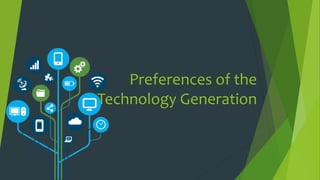
EdTech 2: Lesson 5 and Lesson 6
- 1. Preferences of the Technology Generation
- 2. In the field of education, it is important that critical differences in perceptions between old and young which create a generation gap need to be discussed.
- 3. Single and multi-track activity patterns The old generation has availed of slow and single- track pattern of activities. The new generation is exposed to quick flicking video games, mobile phone texting, socializing through the social websites, and downloading text/music/photos/video with adeptness and task-switching speed.
- 4. Text vs Visuals In order to research, they go to the school library, use the card catalogue for needed books, and sign up to borrow books for home reading. The technology or digital generation has greater affinity to visuals (photos and videos) compared with text.
- 5. Linear vs hyper media The past 30-year old generation has obtained information in linear, logical and sequential manner. On the positive side, this has made them more logical focused, and reflective thinkers. The new generation, however, follows a personal random access to hyperlinked digital information, less superior to elders in focus and reflection.
- 6. Independent vs social learners The traditional education system gives priority to independent learning, prior to participative work. New learners, however, are already acquainted with digital tools that adopt to both personal and participative work.
- 7. Learning to do vs Learning to pass the test Old teachers teach students in order to help them to pass tests and complete the course requirement. The new digital learners simply wish to acquire skills, knowledge and habits as windows of opportunity afford them to learn.
- 8. Delayed rewards and instant gratification The traditional reward system in education consists in the grades, honors certificates/medals, and diplomas. The digital learners on their own experience more immediate gratification through immediate scores from games, enjoyable conversation from web-cam calls, excitement from email chats, and inviting comments from their Facebook account.
- 9. Rote Memory vs Fun Learning Teachers feel obliged to delivering content-based courses, the learning of which is measurable by standard test. Digital learners prefer fun learning which is relevant and instantaneously useful to them. Self - Help
- 10. While there are apparent setbacks or limitations to digital learning, there are opportunities to tap through: The new learners’ digital fluency with visual learning with the use of audiovisuals, media and multimedia; Using hyperlinked multimedia for projects that enhance work focus and reflection; and Problem-solving activities to suit the new generation’s style and preference for fun and relevant learning.
- 12. As teachers adjust their teaching to effectively match the new digital world of Information and Communication Technology (ICT), they must be clear on what basic knowledge, skills and values (or literacies) need to be developed by digital
- 13. Literacy skills: 1. Solution Fluency This refers to the capacity and creativity in problem solving. It requires whole brain thinking executed when students define problem, design the appropriate solution apply the solution, and assess the process and result.
- 14. 2. Information Literacy This involves 3 subsets of skills, namely a. An ability to access information, access may involve not only of the Internet, but other than sources like the CD-ROM software b. An ability to retrieve information, retrieved information may include not only texts, but images, sounds and video. The searches must be perspective of trends in the digital info scope, in the accuracy of data, and in the methodology for data gathering. c. An ability to reflect on, assess and rewrite for instructive information packages.
- 15. 3. Collaboration Literacy This refers to team work with virtual or real partners in the online environment. There is virtual interaction in social networking and online gaming domains. Distance has been abridged, such that learning comes to an exciting potential for partnerships are now possible for multi- cultural learning.
- 16. 4. Media Literacy Media refers to channels of mass communication (radio, Television, Magazine, advertising, graphic arts) or digital sources. There is a need for an analytical mind to evaluate the message in a chosen media, as well as creative ability to publish digital messages, as well as a creative ability to publish digital messages.
- 17. 5. Creativity Literacy Artistic proficiency adds meaning by way of design, art, and story-telling to package a message. 6. Digital Ethics The digital citizen is guided by principles of leadership, global responsibility, environmental awareness, global citizenship, and personal accountability. Self - Help
- 18. Higher Thinking Skills Entering the new world of ICT opens the way for complex and higher cognitive skills 6. Creating – new product / point of view 5. Evaluating – justify stand or position 4. Analyzing – distinguish different parts 3. Applying – use information in a new way 2. Understanding – explain ideas 1. Remembering – recall information The above taxonomy is patterned after new scientific knowledge on how the human brain works
- 19. Right hemisphere the brain works sequentially through a series of events like talking, reading and writing. it is logical and good at decoding along the literal level of meaning. Left hemisphere the brain is good at individual analysis of images, events and ideas.
- 20. By developing higher thinking skills, the school today can inculcate the digital fluencies, while overcoming limitations inherent in digital technology, resulting superficial and mediocre skills of new learners.
- 21. In the instructional process, there is also an instructional shift from lecture-to-tasks to digital tasks-to-learning. - in this approach, skills are developed and the learning outcome is achieved by students themselves.
- 22. 4Ds Define the problem Design the solution Do the work Debrief on the outcome
- 23. The teacher will have to move away from center stage of the classroom, and allow students the limelight of the teaching-learning process.
